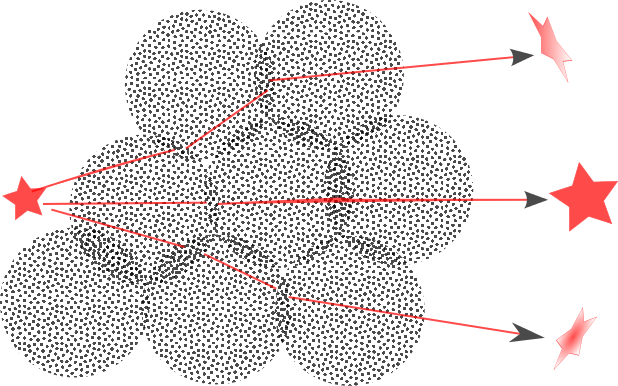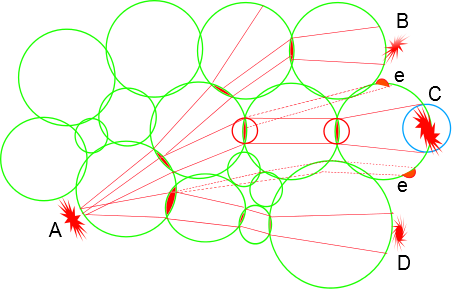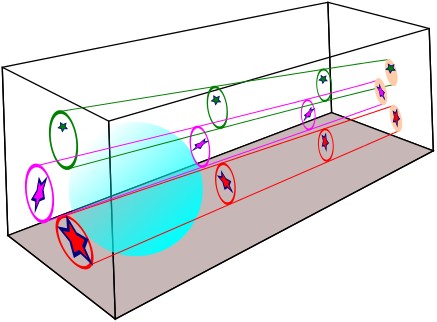
2. How are voids lenses created ?
The deflection of light rays in the transition into another medium is a long-known optical property of light. In the Voids lenses, the deflection of light takes place after this simple law of refraction.
In the huge voids, invisible origin parts are created as a precursor of the "dark matter" which are caused by dynamic processes in the genesis in permanent space creation (this topic I have described in my book "Theory of Everything" in Chapter 6). Thereby at the edges of voids, high concentrations of origin parts are created, which favor the formation of dark matter. The voids therefore do form a denser medium at the edges and the light is thus broken at the transition.
Figure 5: Principle of voids lens effects. The points are for illustrative enlarged primordial particles.
The deflection of light rays in the transition into another medium is a long-known optical property of light. In the Voids lenses, the deflection of light takes place after this simple law of refraction.
In the huge voids, invisible origin parts are created as a precursor of the "dark matter" which are caused by dynamic processes in the genesis in permanent space creation (this topic I have described in my book "Theory of Everything" in Chapter 6). Thereby at the edges of voids, high concentrations of origin parts are created, which favor the formation of dark matter. The voids therefore do form a denser medium at the edges and the light is thus broken at the transition.
Figure 5: Principle of voids lens effects. The points are for illustrative enlarged primordial particles.

The previously known giant voids between the filaments with an average of 100 million light years in diameter are composed of smaller voids.
Figure 6: Large voids are composed of smaller voids
Figure 6: Large voids are composed of smaller voids
Figure 7: The principle of voids lens effects.

The green circles represent the different sized voids and at the edges, as explained above, natural lenses are developed through increased concentrations of invisible matter, the forerunners of the so-called "dark matter".
In the above image the light rays of Galaxy A for example are deflected, enlarged, distorted by different Voids lenses, and appear on the telescope images at different points B, C and D. The Galaxy A is therefore differently distorted and pictured in different sizes. Additionally, on the telescopic images also fragments of the Galaxy A do appear as shown at points "e", which were so far known as so-called "Einstein Rings".
Cosmic Rings in the Voids lenses
The voids lenses consist of an invisible element and are therefore not directly observable. Only with their Lens effects they become apparent. In the telescope images I have therefore drawn circles with a drawing program in order to illustrate the lens effects. The drawn circles in the respective images are all the same size and the underlying principle is shown in simplified form in the following figure.
Figure 8: The turquoise circle is a void that causes lens effects as a kind of "hollow glass ball" and optically magnifies, distorts and breaks a star which is lying behind it into fragments.
In the above image the light rays of Galaxy A for example are deflected, enlarged, distorted by different Voids lenses, and appear on the telescope images at different points B, C and D. The Galaxy A is therefore differently distorted and pictured in different sizes. Additionally, on the telescopic images also fragments of the Galaxy A do appear as shown at points "e", which were so far known as so-called "Einstein Rings".
Cosmic Rings in the Voids lenses
The voids lenses consist of an invisible element and are therefore not directly observable. Only with their Lens effects they become apparent. In the telescope images I have therefore drawn circles with a drawing program in order to illustrate the lens effects. The drawn circles in the respective images are all the same size and the underlying principle is shown in simplified form in the following figure.
Figure 8: The turquoise circle is a void that causes lens effects as a kind of "hollow glass ball" and optically magnifies, distorts and breaks a star which is lying behind it into fragments.
The further we look into the space, the smaller the optical Objects become. The size of the circles, in the picture drawn above shows the distance to the image plane. The further we look into the space the smaller the circles become, just as the imaged objects. I.e. theoretically it is possible to draw many circles of different sizes for different distances in the telescopic images.
Figure 9: Gravitational lens effects with rings.
Figure 9: Gravitational lens effects with rings.

Such rings are also known in the so-called gravitational lenses as shown in the picture above. According to the gravitational lens model, the light rays of celestial objects are redirected by a galaxy, but according to this model, at the center, the galaxy is still visible. However, in the Voids lens effects it is not possible to see objects in the middle, which do deflect the light rays and thus the Voids lenses, as well as the voids themselves are invisible. We still can analyze the Voids lenses based on the distorted images of galaxies.

An optical analysis of voids lens effects
Theory of everything
Figure 10: The "Cartwheel" Galaxy, taken by the Chandra space telescope. The two prominent points in the red clips are shown enlarged below. (Click on the images to enlarge them.)
Figure 11: The Galaxy "Centaurus A", taken by the Spitzer Space Telescope. The optical distortion of the galaxy through voids lenses, as shown by the circles is clearly visible. (Click on the images to enlarge them.)
Figure 12: "Hubble Ultra Deep Field (HUDF)". The red section is explained below.
Source: http://hubblesite.org/gallery/album/pr2012002f
Figure 13: An excerpt from the image above. The drawn circles are to be regarded as a kind of magnifying glasses. The deformation of the galaxies and galaxy fragments at the edges of the circles is caused by the voids lens effects.
Figure 13: An excerpt from the image above. The drawn circles are to be regarded as a kind of magnifying glasses. The deformation of the galaxies and galaxy fragments at the edges of the circles is caused by the voids lens effects.
Red arrows: In this excerpt we see how the galaxies are optically distorted by the invisible voids lenses.
Green arrows: The fragments of the galaxies appear at the edges of the Voids lenses, as well as the so-called Einstein rings in gravitational lenses
Blue arrows: A fragment of white galaxy (solid blue line) appears at the edge of another Voids lens (dashed blue lines).
We can determine the following issues with the analysis of voids lenses:
-With the analysis of voids lenses we can analyze the properties of dark matter and dark energy. Using the voids lens effects, we can examine how invisible matter accumulates at the edges of the voids, which ultimately produce the galaxies in large scale which do stick together.
- We can study the topology of the observable universe. With computer programs, you can create a 3D image with the positions of celestial objects pictured from the thousands of fragments of galaxies.
- Since with our telescopes at large distances we also always do look in the past, we can better examine the basis of the voids in the large-scale motions in the universe. For example we can examine the question whether or the universe rotates.
- We can also examine whether or not the universe is constantly expanding or pulsating cyclic through expansion and contraction (this topic I discussed in my book).
- Since the celestial objects, in the telescopic images are not at the shown positions, we can find out the actual positions of distant galaxies by analyzing the voids lens effects. Here we can also examine the question of whether or not it is possible to almost see around the corner because of the complex voids lens effects.
- With the analysis of Voids lenses we can finally develop a new cosmological model of the universe. The existence of large voids is one of the important clues that speak against the Big Bang model. It's already been known for a long time that according to the cosmological standard model of the Big Bang hypothesis, it is not possible that large voids would arise.
Green arrows: The fragments of the galaxies appear at the edges of the Voids lenses, as well as the so-called Einstein rings in gravitational lenses
Blue arrows: A fragment of white galaxy (solid blue line) appears at the edge of another Voids lens (dashed blue lines).
We can determine the following issues with the analysis of voids lenses:
-With the analysis of voids lenses we can analyze the properties of dark matter and dark energy. Using the voids lens effects, we can examine how invisible matter accumulates at the edges of the voids, which ultimately produce the galaxies in large scale which do stick together.
- We can study the topology of the observable universe. With computer programs, you can create a 3D image with the positions of celestial objects pictured from the thousands of fragments of galaxies.
- Since with our telescopes at large distances we also always do look in the past, we can better examine the basis of the voids in the large-scale motions in the universe. For example we can examine the question whether or the universe rotates.
- We can also examine whether or not the universe is constantly expanding or pulsating cyclic through expansion and contraction (this topic I discussed in my book).
- Since the celestial objects, in the telescopic images are not at the shown positions, we can find out the actual positions of distant galaxies by analyzing the voids lens effects. Here we can also examine the question of whether or not it is possible to almost see around the corner because of the complex voids lens effects.
- With the analysis of Voids lenses we can finally develop a new cosmological model of the universe. The existence of large voids is one of the important clues that speak against the Big Bang model. It's already been known for a long time that according to the cosmological standard model of the Big Bang hypothesis, it is not possible that large voids would arise.
Download this article as PDF-File .
1. Introduction
When viewing the images from different telescopes, I noticed that the lenses have a serious impact on the telescope images as cosmic voids. According to astronomers, the effects on some images are caused by gravitational lenses, however, one on closer inspection, one can see that actually the voids as invisible lenses do cause serious optical effects.
Therefore, the telescope images do not show the reality, as we know it with our cameras, but they do show complex natural lens effects with which our view is adulterated into the depths of the universe with optical illusions. The detailed analysis of the voids-lenses provides us with an alternative explanation for the ubiquitous cosmic lenses.
When viewing the images from different telescopes, I noticed that the lenses have a serious impact on the telescope images as cosmic voids. According to astronomers, the effects on some images are caused by gravitational lenses, however, one on closer inspection, one can see that actually the voids as invisible lenses do cause serious optical effects.
Therefore, the telescope images do not show the reality, as we know it with our cameras, but they do show complex natural lens effects with which our view is adulterated into the depths of the universe with optical illusions. The detailed analysis of the voids-lenses provides us with an alternative explanation for the ubiquitous cosmic lenses.
The Voids
On large scales, there are huge voids between galaxy clusters, the so-called voids with an average of 100 million light-years in diameter. The universe on large length scales has a honeycomb structure, a kind of bubble structure.
Figure 4: The Universe in a spread of one billion light years around the Earth with local super-clusters and voids.
On large scales, there are huge voids between galaxy clusters, the so-called voids with an average of 100 million light-years in diameter. The universe on large length scales has a honeycomb structure, a kind of bubble structure.
Figure 4: The Universe in a spread of one billion light years around the Earth with local super-clusters and voids.

Source: http://de.wikipedia.org/wiki/Void_(Astronomie)
Although the voids have been known for several decades, and the universe is made up of 90% voids, they are poorly understood.
Not only in the macrocosm between planets, solar systems, galaxies, but also in the microcosm, in the atoms and its components, the "empty" space is the relevant element in the universe. In order to understand the universe as a whole, it therefore must first be understood the "empty" space, of which it mainly consists.
Although the voids have been known for several decades, and the universe is made up of 90% voids, they are poorly understood.
Not only in the macrocosm between planets, solar systems, galaxies, but also in the microcosm, in the atoms and its components, the "empty" space is the relevant element in the universe. In order to understand the universe as a whole, it therefore must first be understood the "empty" space, of which it mainly consists.

